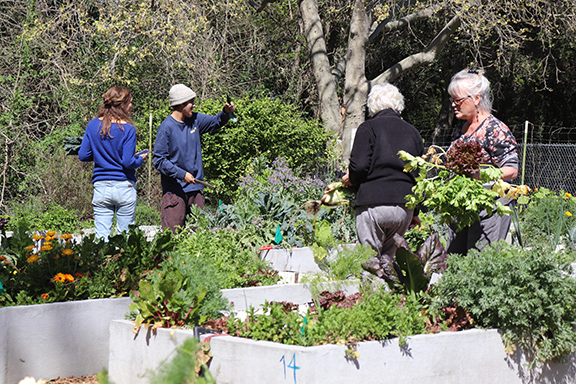First of Two Parts
The challenges facing food production here in the Sonoma Valley have been well documented, including high cost of land and housing, labor recruitment, and competition for farm products from large outside farms and retailers. With land at a premium, alternative public and private options create opportunity.
School gardens have been successful in creating space for growing food while complementing the educational experience. Community gardens, such as our own Springs Community Garden at Larsen Park, and the City-owned Sonoma Garden Park on 7th Street East, have brought opportunity to valley residents to garden, commune, and experience nature. Some multi-housing developments have shared gardens as well. Community members lacking room or sunlight for gardening or companionship in that effort can participate in growing food, flowers, herbs and medicine – or volunteer to maintain gardens, support events, or simply enjoy the lush and productive setting.
The benefits of public gardens for our community – including food production – are exceptional, and community gardens should be supported and developed near large population centers. However, community gardens do not feed the majority of our Valley. The food we eat generally comes from grocery stores (Sonoma Market, Whole Foods, Safeway, Lucky, or one of the many small markets in the Springs and Valley); big box stores out of town (Costco, Trader Joes, Grocery Outlet, Walmart); and, for about 3 percent of us, our local farmers markets or food distribution non-profits.
While grocery stores are valued employers and provide great service and convenience at (usually) reasonable prices, they offer little food produced here in the Valley, although Sonoma Market carries produce from Paul’s Produce and the Patch.
“Sustainable” and “Resilient” have been popular descriptors for aspirations of how we would like to see our communities develop. In order to live up to these objectives, local food production is a major component. The few dozen acres we currently have in production for produce have been estimated to feed about 3-to-4 percent of the Valley (20-to-50 folks fed per acre, depending on seasonality, intensity of production and other factors). If we were to ramp up those numbers to growing for 10 percent of our hungry masses, we would need another 100-plus acres in production.
When we look around, we can see there is open land, sometimes publicly owned at parks or open space (the Vallejo property and former Sonoma Developmental Center come to mind). And much private land, with a large portion currently used as vineyards, as well as some livestock and dairy or hay, which is a use for food production on its own. The question is, can we identify land suitable for farming (and ranching) and find ways to access and develop it. That will require easements, lease contracts, direct purchase, and funds for improvements and upgrades like wells, fencing and farmer housing. It will also require that we find the farmers and workers to grow the food. The answers will come when we look at this issue as a community, from the standpoint that, when we create opportunity for farmers and food producers, we increase local food availability.
The recent national government shut-down placed food security issues front and center. With one-in-eight U.S. citizens benefitting from food subsidies via SNAP and other programs, there was an immediate vacuum felt across the country. Food banks scrambled to secure donations and increase outreach. Our local farms, in their generosity, have long been a source of donations to food banks such as FISH, Food For All/Comida Para Todos, and others. Paul Wirtz of Paul’s Produce estimates his farm donates on average 4 large cases of produce per week, over 200 per year. And Haystack farm, a philanthropic enterprise, donates all of their harvest, estimated at 20,000 pounds and an endearing 2,500 bouquets of flowers. Little Paradise Farm as well as the Robledo family have opened up some of their property to food production for donation, another generous and helpful contribution. This shows that if we increase overall food production and farmed acreage, we naturally increase local food resiliency and sustainability.
In Part 2, we will be diving into the community farm model, what that may look like and how Sonoma Valley can develop such a beneficial system.
(Seth Dolinsky is Lecturer of Sonoma Valley Grange, whose motto is: Healthy Farms, Healthy Food, Healthy Community.


Comments are closed.